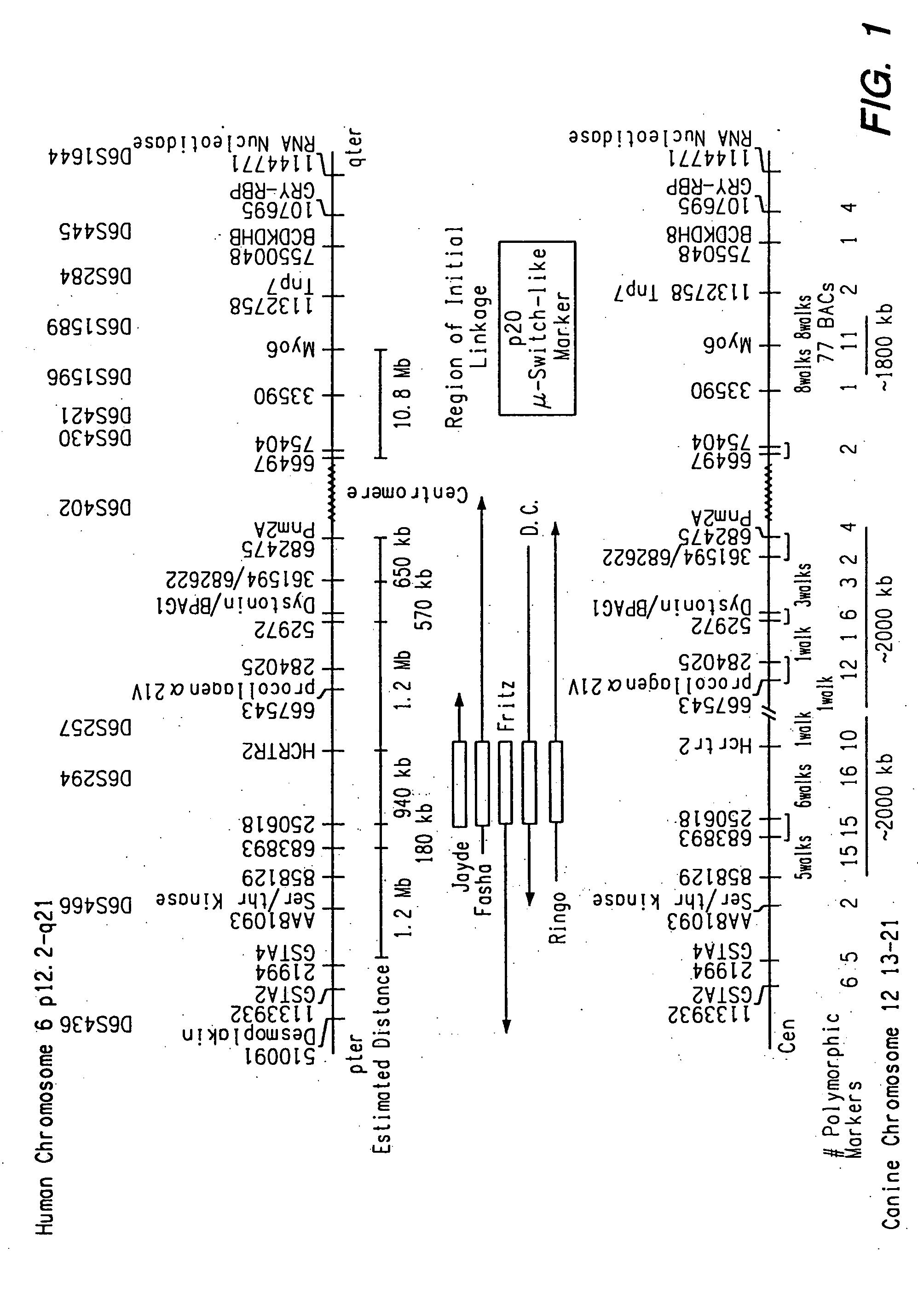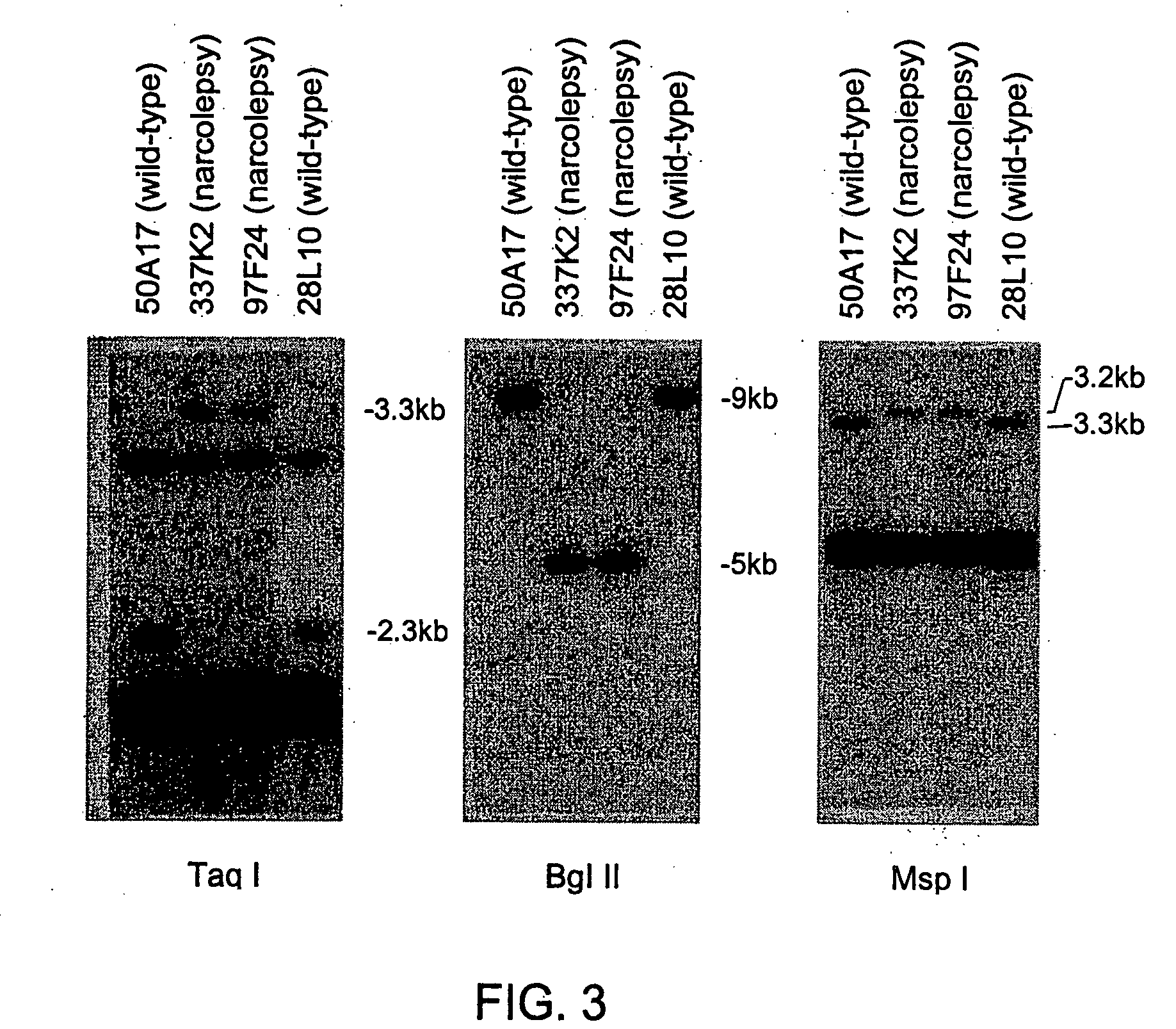Hypocretin receptor in regulation of sleep and treatment of sleep disorders
a technology of hypocretin receptor and sleep disorder, which is applied in the direction of animal/human proteins, biochemistry apparatus and processes, peptide/protein ingredients, etc., can solve the problems of complex picture, hypersensitivity to cholinergic stimulation, and poor understanding of sleep generation at the molecular level
- Summary
- Abstract
- Description
- Claims
- Application Information
AI Technical Summary
Problems solved by technology
Method used
Image
Examples
example 1
Identification and Detection of Canine Narcolepsy Mutations Altering the Hypocretin Receptor 2
[0152] a) Methods and Materials
[0153] The following Methods and Materials were used in the course of performing the work described in Example 1.
[0154] i) Canine Subjects and Genetic Linkage Analysis:
[0155] Backcross narcoleptic Dobermans and Labradors were produced in our breeding colony at the Center for Narcolepsy as described in Cederberg et al., (1998), supra. The procedure to determine phenotypic status for these dogs is described in Mignot (1993) J. Neurosci. 13, 1057-1064; Mignot et al. (1993) Psychopharmacology 113, 76-82. All experimental procedures were done in accordance with the NIH guidelines for laboratory animal care. Two familial cases of canine narcolepsy were reported to our attention for therapeutic advice by a veterinarian and a breeder respectively (see text). Diagnosis for these cases was verified by phone interview and breeding into the colony whenever possible (o...
example 2
Identification of a Restriction Fragment Length Polymorphism (RFLP) in the Vicinity of the Hypocretin Receptor 2 Gene
[0181] Only one previously identified gene, Hcrtr2, was known to reside within the critical region identified in Example 1. This gene encodes a G-protein coupled receptor with high affinity for the hypocretin neuropeptides. To explore the possibility of an involvement of Hcrtr2 in the etiology of canine narcolepsy, BAC clones containing either the canarc-1 or the wild-type associated haplotypes were identified using previously identified polymorphic markers (see FIG. 2).
[0182] Narcolepsy (337K2, 97F24) and control (50A17, 28L10) allele associated BAC clones containing the canine homolog of the HCRTR2 gene were digested with four enzymes (Hind III, Bgl II, Taq I, Msp I), electrophoresed, transferred to nylon membrane and hybridized with a human hypocretin receptor 2 EST probe (IMAGE clone 416643 (HCRTR2)). A clear Restriction Fragment Length Polymorphism (RFLP) patte...
example 3
Canine Narcolepsy is Caused by a Mutation in the Hypocretin Receptor 2 Gene
[0183] With the above as guidance, PCR was performed to further characterize the polymorphism associated with narcolepsy. Briefly, total RNA extraction and mRNA purification from wild-type (4 Dobermans, 2 Labradors) and narcoleptic (4 Dobermans, 2 Labradors) dog brain were performed using the Rneasy Maxi (Qiagen) and Oligotex mRNA Midi Kits (Qiagen) respectively. First-strand cDNA was generated using mRNA (1 μg), AMV reverse transcriptase (SuperScript II RT; 200U; GIBCO BRL) and E. coli RNaseH (2U) according to the manufacturer's recommendation. PCR primers and conditions for RT-PCR amplification are described below. The PCR products were then sequenced and the resulting sequences compared with normal sequence to identify narcolepsy-causing mutations. Specific PCR amplification experiments are described in more detail below:
[0184] a) PCR of Wild-Type and Narcoleptic Doberman DNA using 5′ and 3′ Hcrtr2 Seque...
PUM
| Property | Measurement | Unit |
|---|---|---|
| temperature | aaaaa | aaaaa |
| temperature | aaaaa | aaaaa |
| temperature | aaaaa | aaaaa |
Abstract
Description
Claims
Application Information
 Login to View More
Login to View More - R&D
- Intellectual Property
- Life Sciences
- Materials
- Tech Scout
- Unparalleled Data Quality
- Higher Quality Content
- 60% Fewer Hallucinations
Browse by: Latest US Patents, China's latest patents, Technical Efficacy Thesaurus, Application Domain, Technology Topic, Popular Technical Reports.
© 2025 PatSnap. All rights reserved.Legal|Privacy policy|Modern Slavery Act Transparency Statement|Sitemap|About US| Contact US: help@patsnap.com



